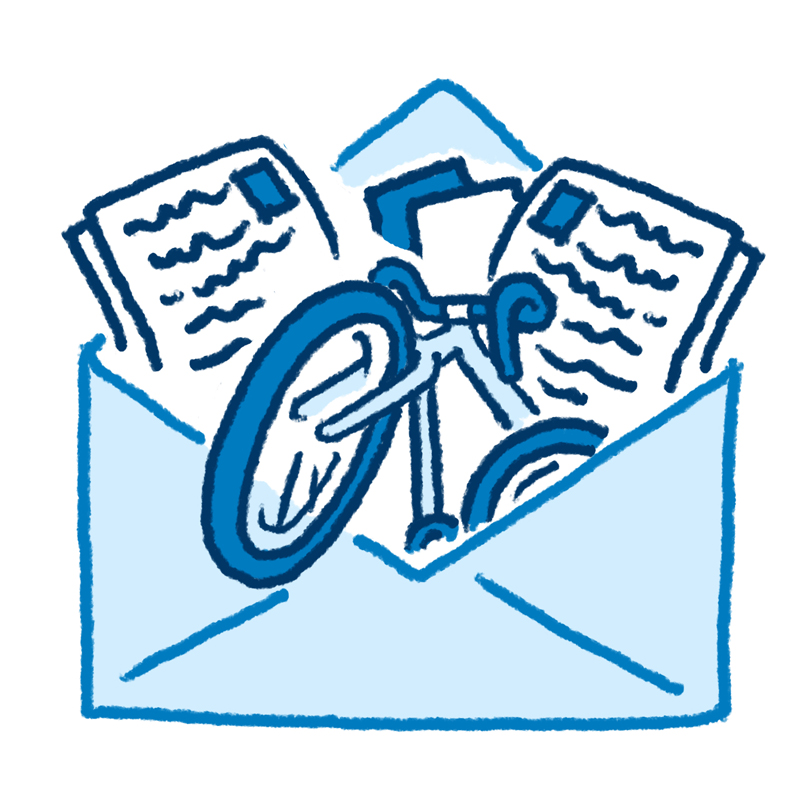Food and Water Strategies for Bikepacking
Water and food are always an important basic need for cyclists, and the remote nature of some bikepacking routes makes self-reliance absolutely essential. Knowing your route can help you strike the right balance between going thirsty and hungry and lugging an unnecessarily heavy load. However, always err on the side of having too much water and food rather than too little.
Water
You’ll want to sip water throughout the day to avoid dehydration. For many cyclists this means 2 or 3 big gulps every 20 minutes, or at least 3.5 liters of water every 5 hours. In especially hot climates you may need more, but don’t go crazy; it’s actually possible to drink too much water, especially if you don’t replenish electrolytes (more on this below). If water is limited, stretch your supply further by drinking a liter every time you fill up, camping near water whenever possible, riding at cooler times of the day, and using the bare minimum for washing and cooking.
Filtering Drinking Water
It’s easiest to fill up with potable water at restaurants, convenience stores, or campgrounds, but between these stops, bikepackers often need to drink from natural sources like streams or lakes … and sometimes less pristine sources like cattle tanks and muddy ponds.
Always filter or purify water from natural sources to avoid getting sick from waterborne pathogens like Giardia. A lightweight backpacking filter like the Sawyer Squeeze catches bacteria and parasites, which is sufficient in the US and other infrastructure-rich countries. In places where sanitation infrastructure is lacking, you’ll want a purification method — like UV radiation or chlorine dioxide drops — that deactivates viruses too.
Electrolytes
When we sweat, we lose electrolytes as well as water. These electrolytes (including sodium, potassium, calcium, magnesium, and chloride) need to be replenished to avoid muscle cramps and keep your body healthy. Normally a balanced diet is enough, but in very hot weather you might need extra salty snacks or an electrolyte replacement drink.
Even if you’re drinking water and replenishing electrolytes, dehydration can sneak up on you in hot weather. If your urine is a dark color or if you’ve gone many hours without urinating at all, it’s time to take a break in the shade, drink water, and eat some healthy, salty snacks.

Food
Food is literally the fuel that keeps a bikepacker’s pedals spinning. But riding through remote areas with small bike bags and a big appetite presents some challenges. Some people pack all their food for the whole trip in advance, others cram their bags full of grab-and-go meals from convenience stores along the way. Choose the best strategy for your dietary needs, route location, and riding style.
Resupply Strategy
For a trip of around three days or less, it’s reasonable to carry all your food from the start. You might still research any towns along the way so you don’t miss an opportunity to stop for burgers and ice cream.
For longer trips, a common rhythm is to carry food for several days at a time, resupplying with whatever is available at towns along the way. This gives you less control over your diet, but takes pressure off the planning and packing process.
Many people mix these strategies, leaving home with a few dehydrated meals and some hard-to-find ingredients, and buying most snacks and staples along the way.
How Much Food?
Budget at least 3,000 calories per day, maybe closer to 4,000 for demanding trips, depending on your body and metabolism. Always keep a few emergency snacks tucked away, and it wouldn’t hurt to pack a full extra meal for each stretch in case of unexpectedly slow conditions.
Eating on a bikepacking trip is an all-day activity, so plan to get at least a third of your calories from snacks. Snack early and often; don’t wait until you’re feeling hungry or tired. An open bag of trail mix in a stem bag makes it easy to snack on the go.
To save weight and space, plan your menu precisely. Some people partition each meal and day of snacks into separate bags so they know exactly how much to eat and how much to save for tomorrow. Remove all unnecessary packaging, like outer boxes or wrappers, to save space and reduce the amount of trash you’ll need to pack out.

What to Eat
Nutrition
A healthy diet on a bike trip isn’t much different from a healthy diet at home; it’s just a bit harder to accomplish. You can generally “get away with” underpacking calories or overdoing junk food on a short trip, but over many days this can add up to low energy levels and negative health impacts.
It helps to think in terms of the three macronutrients: carbohydrates, fat, and protein. You may have heard that carbs or fat are “bad,” but that’s usually just a question of amount. We need them all, and especially when we’re getting lots of exercise there’s usually no reason to avoid them. Carbohydrates give us quick energy, fat gives us slower-burning fuel reserves, and protein helps our muscles grow and recover. Overdoing sugary processed food still isn’t the healthiest idea even while bikepacking, but if you do have a sweet tooth, there’s no better time to indulge a bit.
That said, nutrition science is always evolving and there are many ways to eat a healthy diet. If you know what works for your body, stick with it.
Food Availability
Your food options will depend on where you’re riding.
Small towns typically have a general store with basic snacks and grab-and-go meals, and perhaps a diner serving burgers and chicken strips. You’ll find plenty of jerky, chips, instant noodles, and microwave burritos, but don’t count on fresh veggies or your favorite brand (or any brand) of quinoa. Larger towns with grocery stores and fresh food may feel like paradise after a few days on the trail, but they also take more time and energy to navigate.
Space and Weight
Bikepackers usually try to pack the most calories into the smallest and lightest package possible. This means choosing foods that are:
- High in fat like trail mix, full-fat cheese, and nut butter
- Low in water content like couscous, instant noodles, or dehydrated backpacking meals
- Compact like trail mix and cheese rather than chips
- Durable like freeze dried versions of fruits and vegetables
To cook or not to cook?
A stove, pot, and fuel take up space and add weight, so think carefully before you decide to cook on your bikepacking trip. If you’ll be passing through towns once every couple days, it’s possible to eat a satisfying menu of no-cook snacks plus the occasional grab-and-go meal from a convenience store or restaurant.
Cooking is most appealing if you have specific dietary restrictions, your route has long distances between resupplies, or you really enjoy the process of cooking at camp. If a hot cup of coffee in the morning is all you really need, consider a lightweight solid fuel or alcohol stove.
Food Ideas
These foods can be found in many small grocery stores throughout the United States.
- Healthy no-cook snacks
- Hard aged cheese, wax-wrapped cheese, or string cheese
- Jerky, meat sticks, or salami
- Trail mix and nuts
- Nut butter
- Protein or energy bars (look for higher fat and lower sugar)
- Dark chocolate
- Hummus with tortillas
- Grab-and-go meals from convenience stores
- Frozen burritos (let them thaw in your bag during the day)
- Sandwiches
- Canned food (heavy but convenient and can be eaten cold)
- Cheese and salami with tortillas
- Quick-cooking meals available in most convenience stores, and secret ingredients to spice them up
- Instant oatmeal (add nuts and dried fruit)
- Ramen (add peanut butter and hot sauce — really!)
- Instant mac-and-cheese (add extra cheese, bacon bits, salami, or dried veggies to this and the next two)
- Couscous
- Instant mashed potatoes
- Ingredients to buy at home and add to meals along the way
- Powdered butter, coconut oil, cream, or other high-fat powder to mix into meals
- Powdered milk to add to oatmeal or instant coffee
- Freeze dried vegetables
- Dried bean flakes
- Spices and seasoning packets
Up Next: Camping: The Joyous Backbone to Bikepacking


